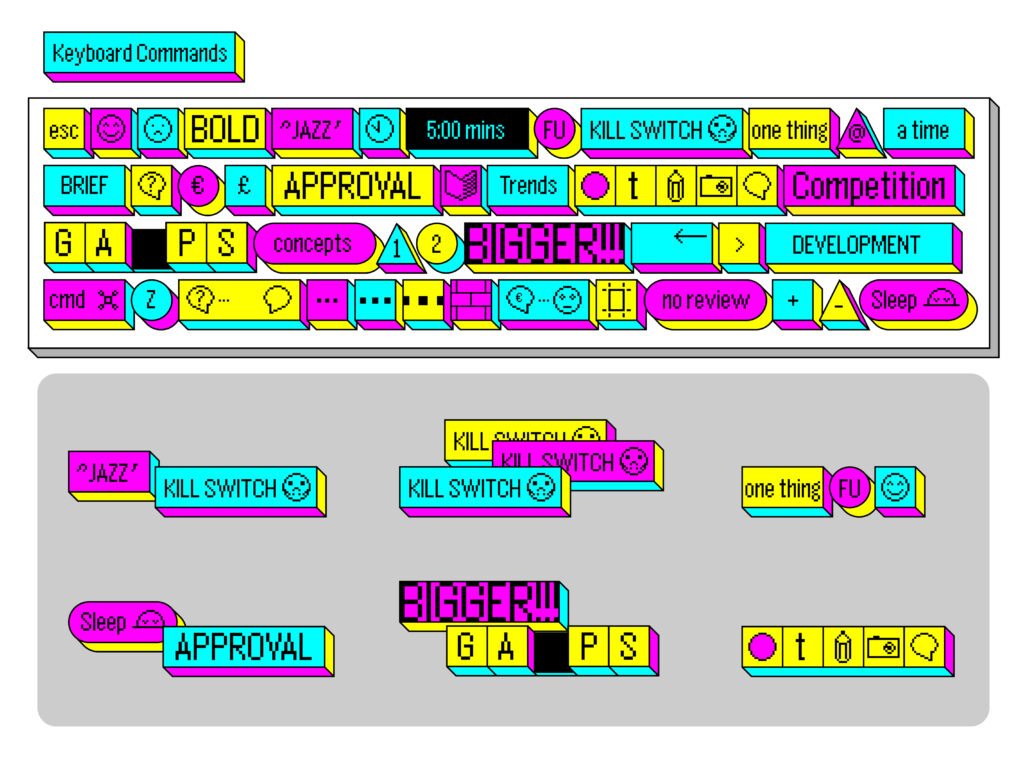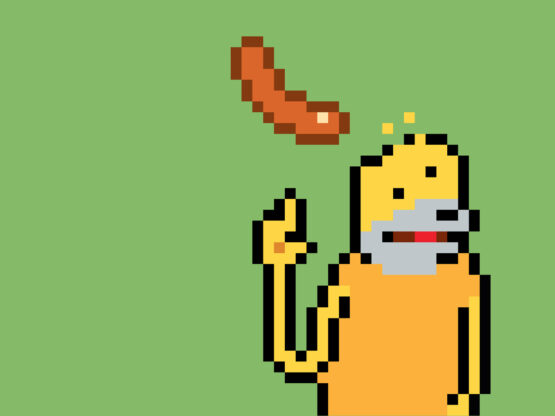REFLECTIONS ON LECTURES/SOURCE MATERIAL:
What would you like to be doing that you are not doing in your work?
Overall the lecturers were happy with the work they are doing and they are incorporating their own passions into the work that they create on a day to day basis.
Simon Manchipp makes an interesting point that the variety of projects that he works on are strategically led and transformative in helping lay plans for people to build their lives on, and it's this variety and constant learning that keeps him engaged. In his own word's "it's terrifying. It's true that through working for a variety of clients, the gained learnings and experience is invaluable; however I find Someone to be in a very different space to that of the other lecturers. I have personally worked under this strategic and business focused structure and found it to be creatively unfulfilling because there are so many tiers of approval you have to go through and any ownership of the work is lost. This is even if the project comes out of the other side fairly unscathed. The process you have to go through can be arduous for the designer and very often you feel like the work has been 'designed by committee'.
"We’re born monkeys and we somehow developed the system of… rules of…culture, and…society".
Sam Winston
—
Sarah Boris seeks to collaborate more with product designers creating work from the home through a recent interest in different materials. I think our connection with materials can sometimes get lost in the digital space and it is important to stay connected to the physical. Regular Practice find themselves coming back to previous ideas and treatments, and look for ways to incorporate them into a new project. I have always followed Derek Birdsall's mantra that if an Idea is good there is no reason why it can't be re-envisioned in new work in some way. Adrian Talbot talks about the importance of personal projects for creative headspace (Talbot Type). I think this is true but as Tom Finn say's in the following lecture – it's finding/making the time to do it.
A PERSONAL PERSPECTIVE
One of the reasons I enrolled on the course was to find a way in with my day to day to bring in original thinking and creativity. I feel that, while I am extremely passionate about and love the work I do, – there is not enough of myself in it. I also want to break out of the role of just being seen by my peers as the go to "packaging" designer and to shift the focus of my practice to becoming a more rounded design company and with a printed matter offering for cultural, arts and music industries.
TAKE OUTS
— Keep the projects varied and you will never stand in one spot
— Keep the physical materials in mind
— You 'can' bring your own voice to your day to day
— Collaboration will open doors and new areas of creativity
How important are side projects, and are you currently working on any?
Very different viewpoints from the lecturers on this. Simon Manchipp refers to his side projects in monetary terms whether small projects he did before he started Someone or the digital platforms he is developing, however his point about being able to discover and learn from creating outside of just being a service based business is a valid one. I think Sam Winston's assertion that giving yourself space is also important. It goes back to an earlier lecture in week one where Paula Scher talks about taking herself out of a situation to come up with ideas and to just think. Some of my own 'best' ideas have come out of the moments when I'm daydreaming - smoking a cigarette or on the loo. Regular Practice make a valid point on being able to have authorship/ownership of the work you are creating. I also agree that 'making' the time is important. As Sarah Boris say's the work can define and differentiate you as a designer and lead to more interesting and fulfilling work as you are being commissioned for what you create. I am not sure that I agree that the self initiated projects always have to to have a criteria, reason to gain some validation as outlined by INTRO. You could use the work just to explore new avenues and then bring these creations into the work you make for clients. Although I do agree that the internet becomes a vacuum where only designers comment on your work. I suppose what they are talking about is the ability for your work to be seen by a wider audience in the real world – not design, just for designers.
A PERSONAL PERSPECTIVE
I am using this course to explore and push my own limitations as a designer. Even though we are set weekly projects I see this as a way to explore the self, what my identity or voice is as a designer, and to find new ways for self expression within the confines of a project brief. I have had a few side projects in a sub-folder like Regular Practice for some time now… maybe it's time to explore them further.
TAKE OUTS
— Take time and space to think and create
— Make time for your own projects/ideas
— Self initiated projects give show off your identity, authorship/ownership of the work and can lead to new commissions
— Don't seek validation just from your peers
VALIDATION
Some of the points about giving yourself breathing space were first put into practice by James Webb Young.
In 1940, advertising executive James Webb Young published a short guide titled, A Technique for Producing Ideas. In this guide, he made a simple, but profound statement about generating creative ideas.
According to Young, innovative ideas happen when you develop new combinations of old elements. In other words, creative thinking is not about generating something new from a blank slate, but rather about taking what is already present and combining those bits and pieces in a way that has not been done previously.
Gather new material. At first, you learn. During this stage you focus on 1) learning specific material directly related to your task and 2) learning general material by becoming fascinated with a wide range of concepts.
Thoroughly work over the materials in your mind. During this stage, you examine what you have learned by looking at the facts from different angles and experimenting with fitting various ideas together.
Step away from the problem. Next, you put the problem completely out of your mind and go do something else that excites you and energizes you.
Let your idea return to you. At some point, but only after you have stopped thinking about it, your idea will come back to you with a flash of insight and renewed energy.
Shape and develop your idea based on feedback. For any idea to succeed, you must release it out into the world, submit it to criticism, and adapt it as needed.
(Retrieved From: https://jamesclear.com/five-step-creative-process).
"Honor thy error as a hidden intention".
Brian Eno
—
Some interesting debates about the nature of genius on the ideas wall. Abbie Marie asks "what makes an artist famous?". I think fame and genius are two different things entirely but today the media plays a part say in the case of Damien Hirst, Tracey Emin or Grayson Perry. In the past I think it was the nature of the high profile commissions. As most art was commissioned by the church, royalty and the rich (Music, Sculpture, Architecture and Painting). According to Artsy.net "The very act of commissioning an artist to design a building, sculpture, or painting signified the patron’s taste, erudition, financial status, and ambition". (Retrieved from: https://www.artsy.net/article/artsy-editorial-italian-renaissance-wealthy-patrons-art-power). You see this in a lot of the work of Rembrandt van Rijn as the Met Museum's website states "the legend that customer dissatisfaction ruined his reputation is refuted by later commissions from such prominent patrons as Jan Six and the Amsterdam city government". (Retrived from: https://www.metmuseum.org/toah/hd/rmbt/hd_rmbt.html).
I personally have never bought into the idea of genius itself. I think for me the closest to genius is a figure like Leonardo Da Vinci who was a painter, sculptor, architect, inventor and scientist. Having an understanding of so many subjects certainly singles you out, but subjectively speaking I think it is more to do with place, time, associations, patrons and most important of all; the body of work created that was of value. I would argue that we would not be speaking about Wolfgang Amadeus Mozart if he had stopped composing aged 7. (Mozart started composing around age 5 ["These early pieces, K 1–5, were recorded in the Nanneri Notenbuch. There is some scholarly debate about whether Mozart was four or five years old when he created his first musical compositions, though there is little doubt that Mozart composed his first three pieces of music within a few weeks of each other: K. 1a, 1b, and 1c."]/Retrived from https://en.wikipedia.org/wiki/Wolfgang_Amadeus_Mozart).
James asks what strategies we use to relieve creative block. I've always found removing yourself from the situation to be the best one or even doing something else and coming back to the problem later because your brain is whirring away in the background solving the problem subconsciously. I like Brian Eno's tangental approach or "Oblique Strategies". In some way they are as abstract as some of the music he makes. I am not so sure that it would work in a design scenario and am actually enjoying my new found joy in making mind maps which gives me my own avenues of thought.
However - I thought it would be fun to turn a few client expressions on their head and make a few cards of my own.
CONFLICT RESOLUTION CARDS
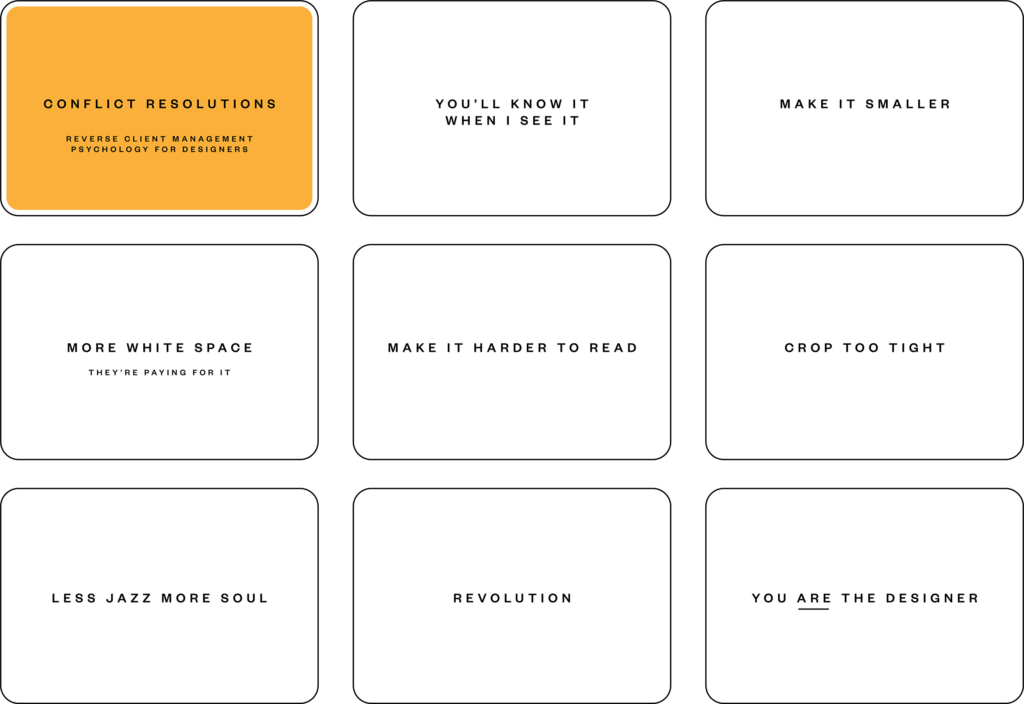
Enjoyed the School of Life films about both Vulnerability and Perfection. We sometimes forget that life skills - the way we act and interact with our peers and clients is a skill in itself to be navigated and understood , and it is actually harder to gauge as you navigate multiple personality types. The friendship element is important to me because once you have a client who trusts you on that different level, you are both collaborating properly towards a better end result.
Workshop Challenge: List of Skills, Working Practice, Thought and Areas for Development.
I created a detailed mind map to look at my skills, working practices and gaps in learning. Some interesting observations have come out of this process.
MIND MAP
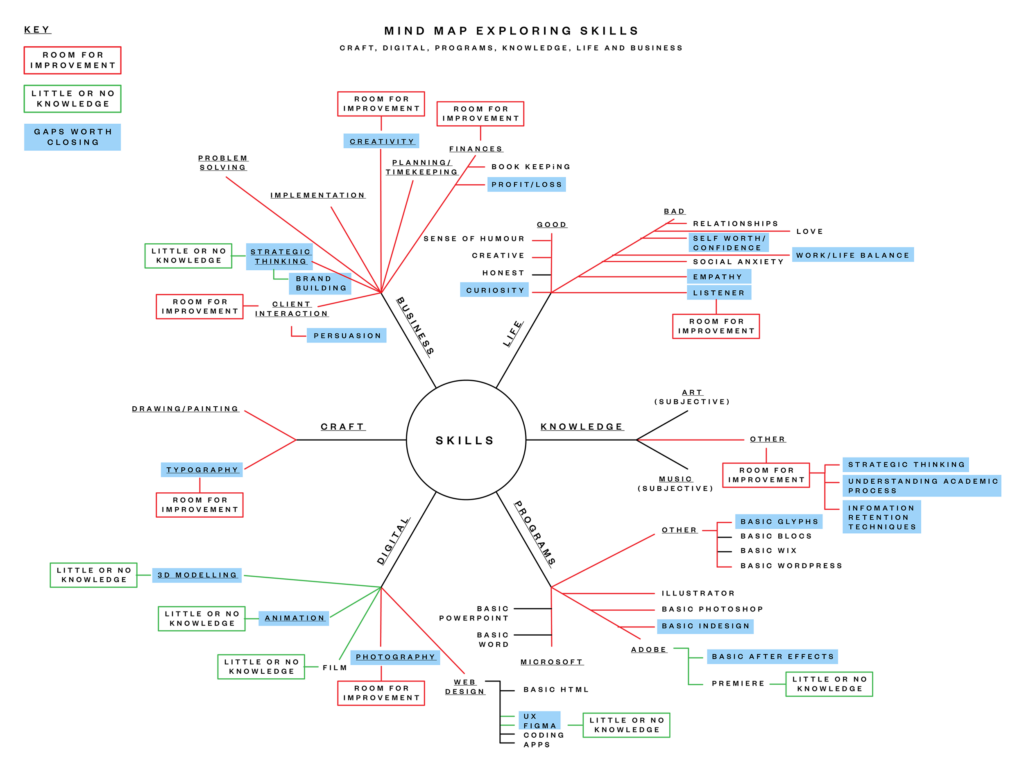
TAKE OUTS
— Craft: Happy enough with my drawing and painting skills. Typography is an ongoing exploration.
— Digital: Need to brush up on InDesign and Photography. Also want to get under the bonnet of Glyphs, After Effects, learn some basic animation skills and 3D Modelling.
— Programs: See above.
— Knowledge: Poor in strategic thinking and brand building. Developing but not there yet an understanding of the academic process and techniques to retain information.
— Life: Need to start believing more and get a better work/life balance. Also important to be more empathetic and a good listener.
— Business: See knowledge for strategy and brand building. Need to get better at the art of persuasion and influence.
— Other Gaps: I have a few other gaps but these are not the core of my focus for my practice going forward.
Workshop Challenge: Summarising the Process Model
CURRENT WORKING PRACTICE
Had a look at my current working process (below) and found further gaps that need addressing:
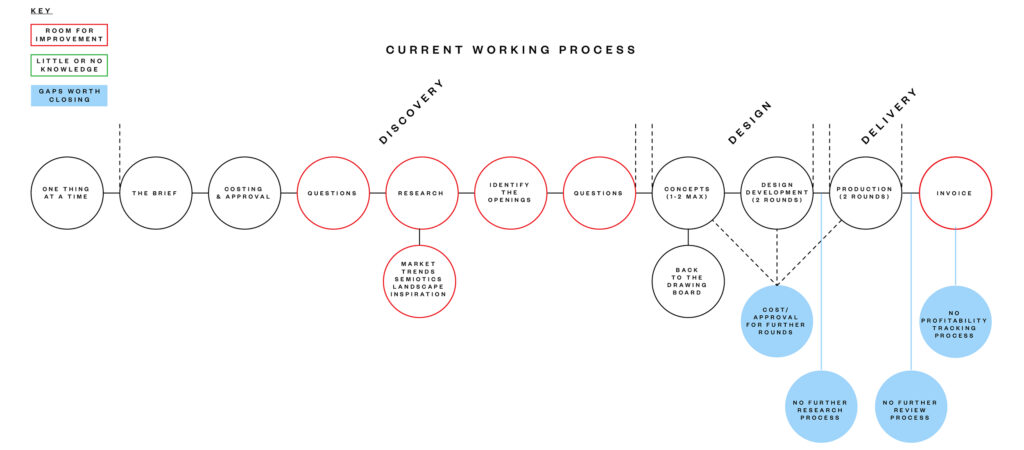
TAKE OUTS
— I am not charging enough for the work I do and my level of experience.
— There isn't any research post either concept or design development rounds of work. This is because of the size of my practice.
— There isn't a review process in place for feedback on: how I performed and how the product performed, is performing in the market.
— I have no idea if I am making a profit or a loss.
SKETCHES
Top: My process as it currently stands with all it's faults and gaps...
I initially thought about just creating an simple infographic but after watching the Regular Practice film for a second time it has opened up some other avenues of thought...
I like the idea of expressing my process as some kind of dysfunctional keyboard where you keep having to go back and hit a restart button as you go back to the drawing board repeatedly...
I'm also interested in changing the heights of certain buttons or having broken or stuck keys as well as random buttons like the circle or triangle where you don't know what the outcome will be.
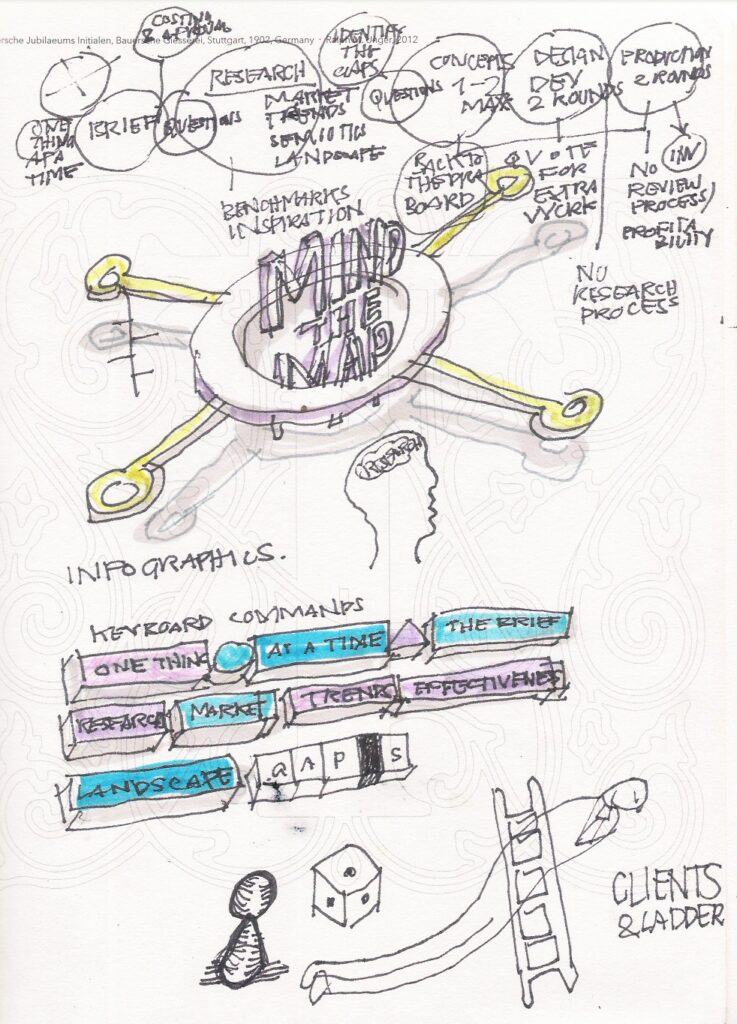
THE IDEAS WALL
Good responses on the work in progress sketches and love James idea about motion - might be something I can explore in more detail over the break as my After Effects skills are basic (see above).
Cheekily we have also been chatting on our facebook page and James also thought wooden blocks could be cool. I love this idea but again time, money and materials is a factor and it's Wednesday so I will be keeping it graphic for now.
I am going to explore this further and maybe even have a look at some 3D modelling to help in the process. Really like the idea of adding random buttons in the process, so will explore further as to how this can work and what it looks like.
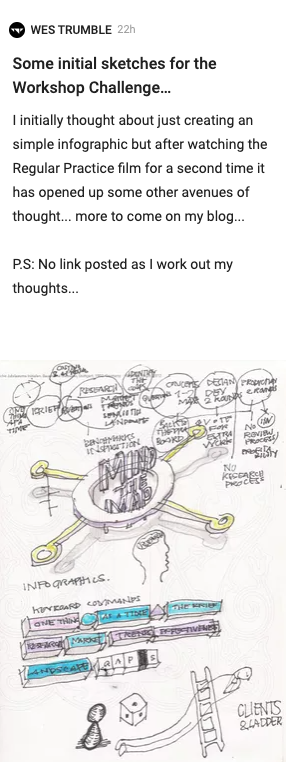
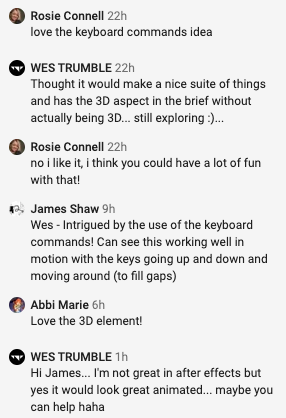
MOODBOARD
Below: Some ideas for colour and how I might represent 3D with 2D (Isometric Grids).
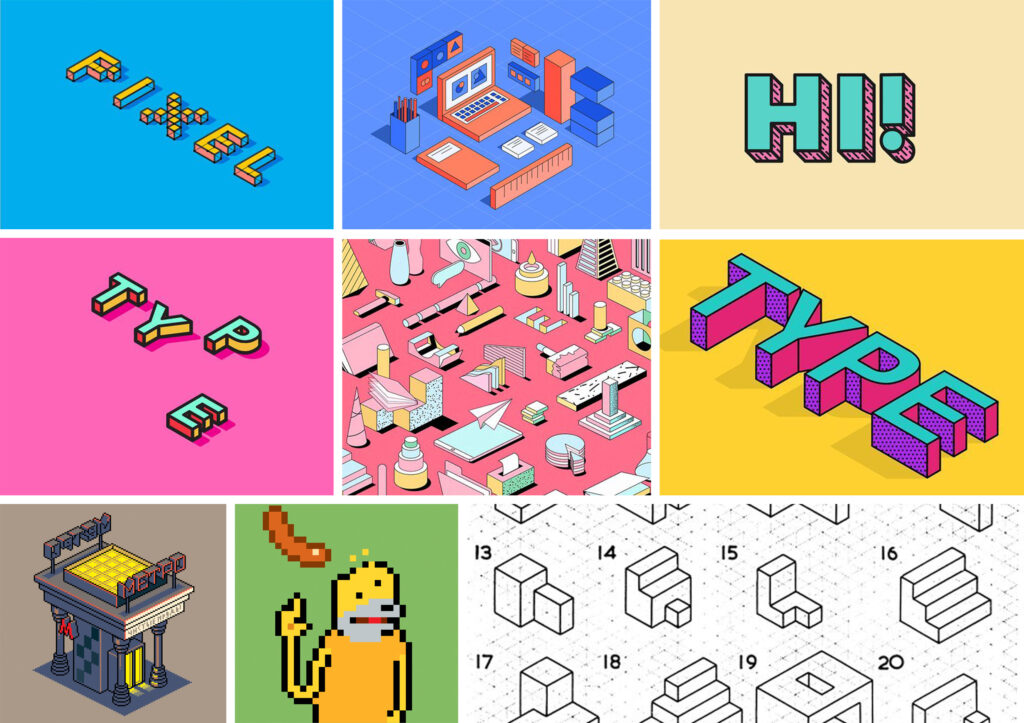
SKETCH EXPLORATION
Below: Further sketches exploring process order in keyboard pattern and icon sets for random keys.
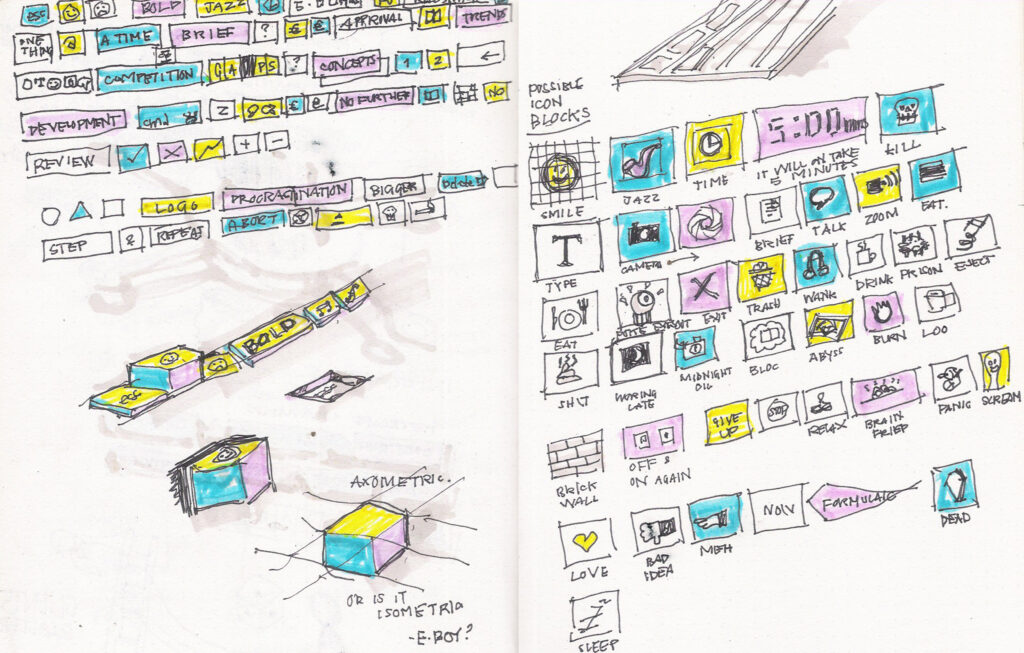
TAKE OUTS
— Don't think I need all the icon blocks but this can be refined as I go along
— Like the idea of mixing the process with pictograms - codify's the process
— Think the Isometric process will work the best but I am going to try a 3D program just to see if it can be used in some way…
3D SKETCHES
Below: Experiments using a kids 3D program (3D Slash) to create a button. I think if I had the skills I would carry on down this path but for now will go with the 2D execution.

WORK IN PROGRESS
Here are some screenshots of the process:
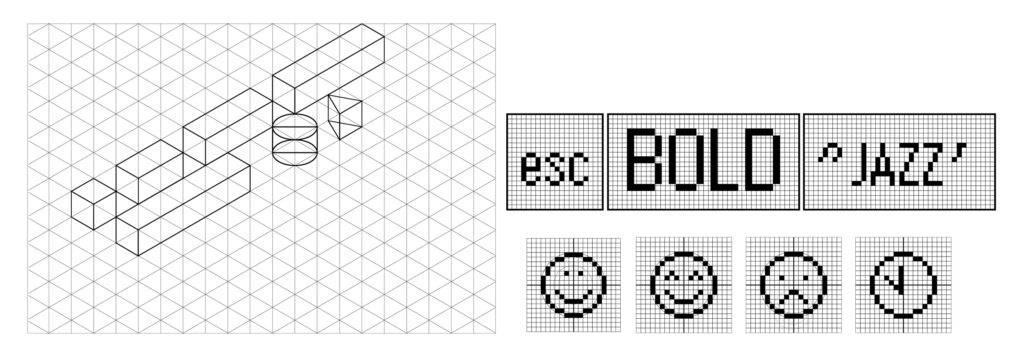
Workshop Challenge: Final Execution
Here's the finished piece with a combination of pictograms and text to explain the process as well as some random keys just to help confuse/codify the process. I can see this being applied to various objects like stress balls and T-shirts. A kind of keep calm and carry on for the present day…
